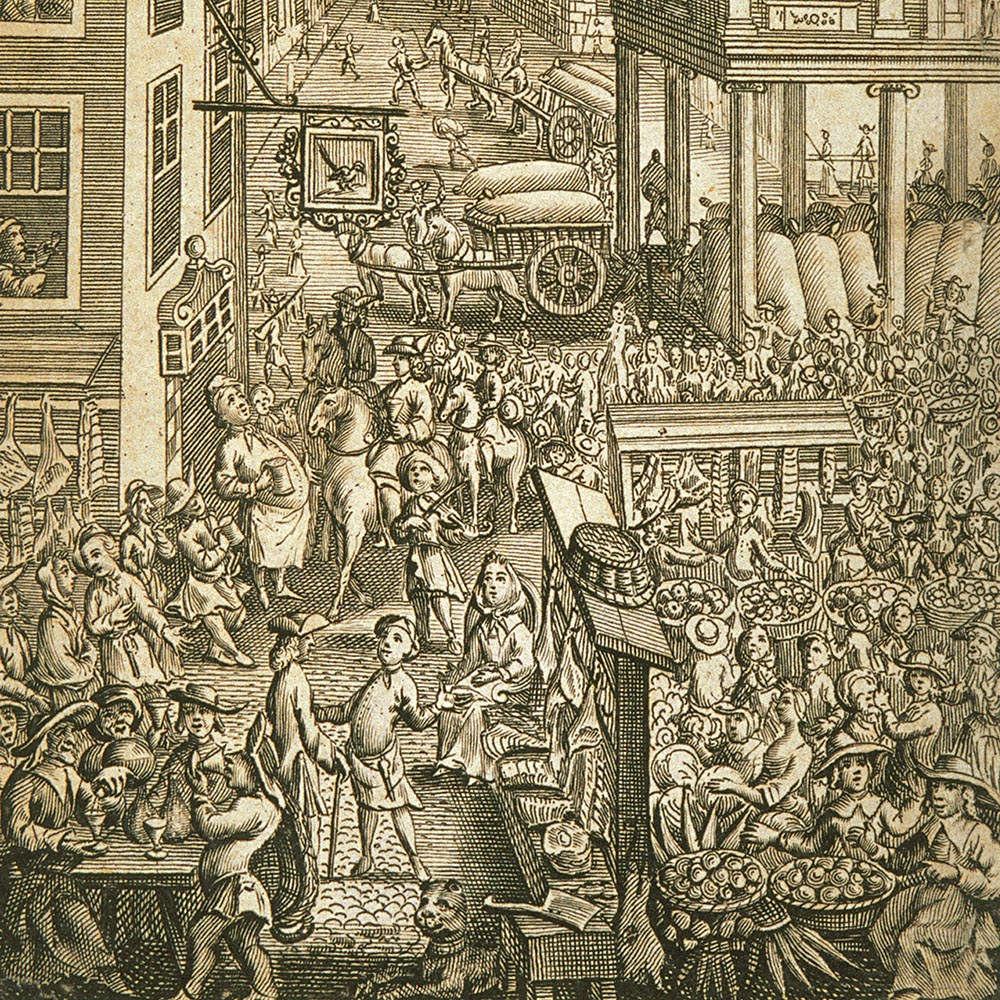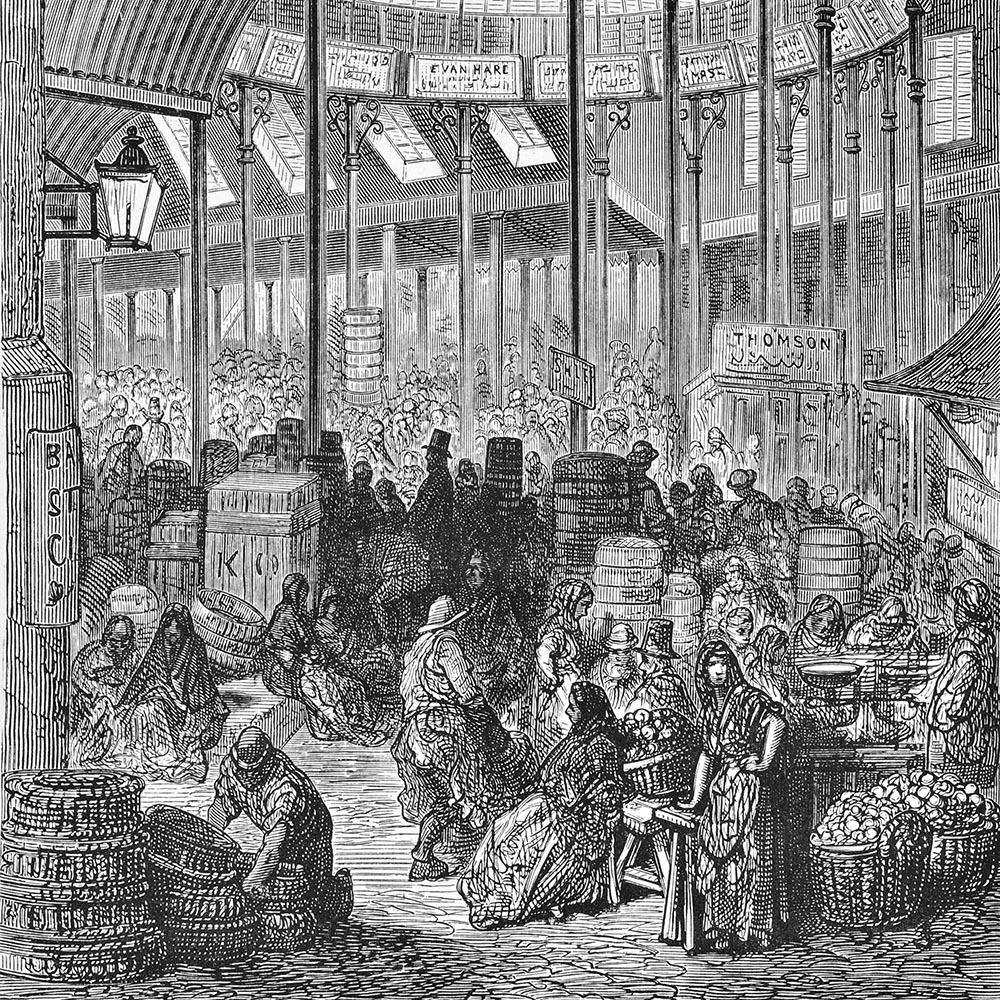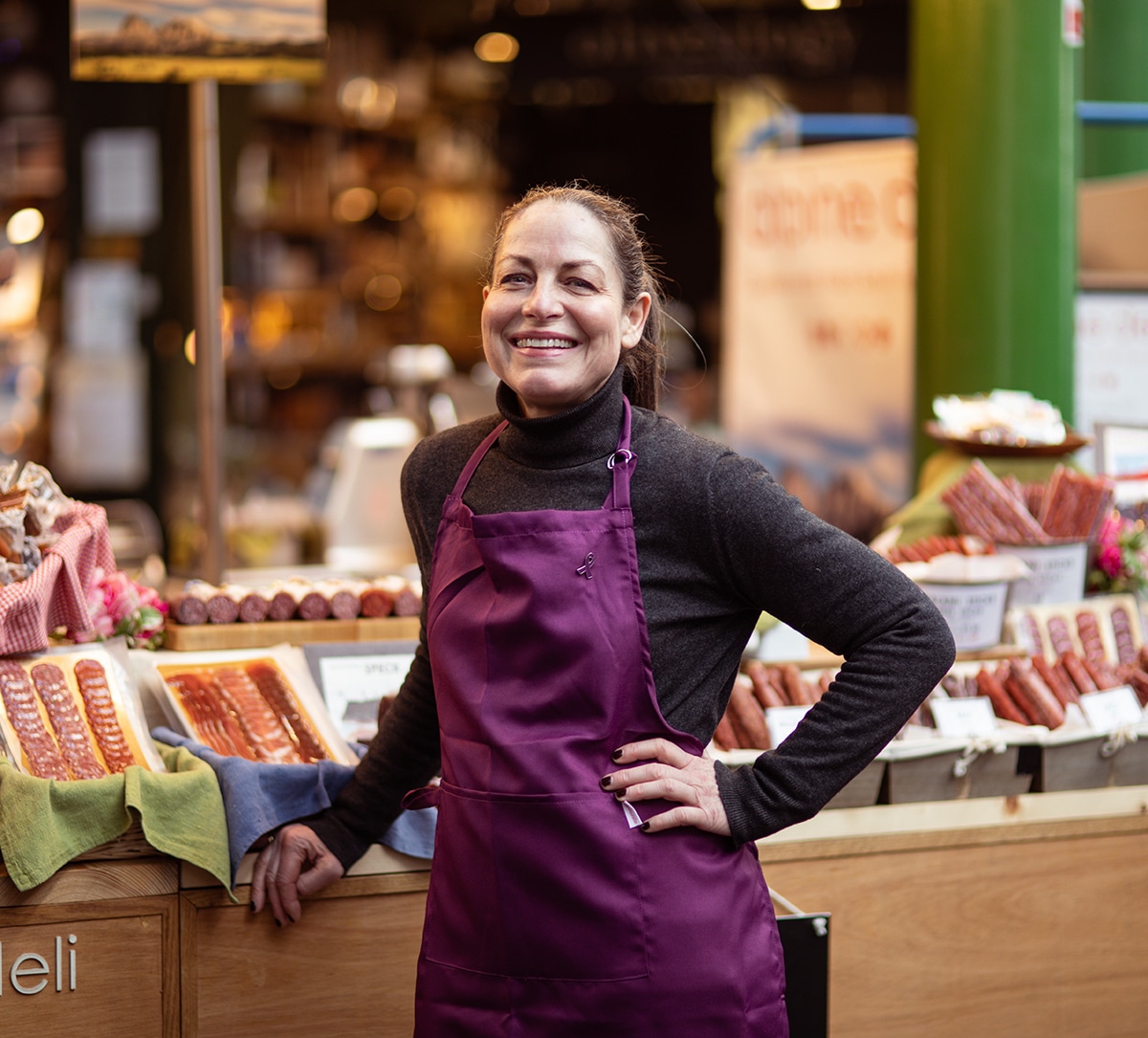Borough Market began with a bridge
Mark Riddaway, author of Borough Market: Edible Histories, explores the rise, fall and rebirth of one of London’s most storied institutions


“AS LONDON GREW IN SIZE, THE BEDLAM ON BOROUGH HIGH STREET BEGAN TO AROUSE OPPOSITION WITHIN THE CORRIDORS OF POWER”
Borough Market began with a bridge. For hundreds of years, London was a small walled metropolis on the north bank of the Thames. Its southern neighbour, Southwark, was an altogether different place – a frontier settlement where different rules applied; a town of pubs and prostitutes, hawkers and hucksters, craftsmen and criminals. The only link between the two – in fact the only route into the City of London from anywhere south of the river – was London Bridge.
First constructed around 990AD, the bridge grew in importance as the city expanded. At its peak, it was a colourful, chaotic landmark – a far cry from today’s grey concrete slab. In fact, the word ‘bridge’ barely does justice to this heaving mass of people, animals and rickety buildings, which was more of a municipality in its own right than a mere river crossing – imagine a small but lively provincial town, all piled up to vertiginous heights in a condensed space and elevated on legs.
The road we now know as Borough High Street was the vital artery joining London to the ports and towns of the south. And as with any major access route anywhere in the world, the bridge, and the road that ran up to it, acted like a magnet for people wishing to sell things to travellers, especially after the murder of Thomas a Becket in 1170 turned Canterbury into a popular pilgrimage site. The presence of such commercial potential kicked off an epic struggle between authorities determined to regulate and tax the market and hordes of small traders who wanted to make as much money as possible with the least possible interference. This fight continued for centuries, enacted through the rather tedious medium of impenetrable paperwork.
The medieval market
For a long time, there were two legitimate marketplaces around Borough. The smaller of these started in the grounds of St Thomas’ Hospital, located at the southern entrance to London Bridge. In 1215, following a disastrous fire, the hospital moved to a new location on what is now St Thomas’ Street, on land that was then part of the manor of the Archbishop of Canterbury, and the market, which specialised in corn, was transferred to the doors of the new site. This market opened three days a week – Wednesday, Friday and Saturday.
A larger market, selling a wider range of produce and trading on Wednesdays and Fridays, found a home along the busy main highway near the foot of the bridge in the area known as the Guildable Manor, which was administered by the crown. Both markets caused constant irritation to the authorities across the river by providing stiff competition to the City of London’s own traders. In the 1270s the City forbade its citizens to go to Southwark to buy “corn, cattle, or other merchandise there”. It also banned traders from setting up on the bridge itself and clamped down on “regratresses” who bought bread in Southwark and resold it for a profit in the City.
But the City’s biggest problem with Southwark wasn’t its markets. The vagaries of the legal system at the time meant that any felon committing a crime in London could, in the words of a petition presented to the King in 1327, “stealthily flee to Southwark openly where no bailiff of the City can attach them”. Frustrated by seeing known criminals blowing raspberries at them from across the river, the City constantly lobbied the crown to hand over its rights to the Guildable Manor. In 1406, Henry IV finally granted London the right to arrest criminals found in Southwark and at the same time granted “assay and assize of bread, wine, and ale and other victuals and of any other things belonging to the clerk of the market of the King’s household”. Borough’s market had, to all intents and purposes, become an extension of London.
The residents of Southwark were far from happy about this encroachment of City types into their town, so fought hard to overturn the new grants, but further charters in 1444 and 1462 cemented the influence of London over the Guildable Manor and added the right to hold a three day fair every September. Southwark Fair would go on to become one of the biggest and most riotous events in London’s calendar.
In April 1550, for a price of just over £1,000 (£647 for the land, £333 for the liberties and £25 for expenses), Edward VI ended for good any debate about who ran Borough by selling Southwark to the City. In the same charter, it was agreed that the Guildable Manor market could extend to four days a week, adding Monday and Saturday to the schedule.
Organised chaos
The Southwark of the 16th and 17th centuries was a hive of activity – partly a busy commercial district, where leather, felt, pottery and soap were crafted and sold, partly a giant travel terminus, and partly a seething maelstrom of licentious behaviour, packed full of pubs, brothels and theatres. Londoners flocked across the river to let off steam – think Kavos or Ibiza, but with fewer foam parties and more Shakespeare – while farmers trundled in from the countryside with herds of cattle and sacks of grain, seeking to make a living on the heaving high street.
Out of this chaos, the City did its utmost to create some kind of order, with limited success. Traders were supervised by bailiffs and constables who together enforced price controls, inspected goods and collected fees. A weighing beam was situated next to the pillory in the middle of the high street, and it was here that sacks of grain were weighed in public before being put on display. Towards the end of the 16th century, a market house was built at this location to keep the grain safe from the elements.

The authorities faced a constant battle to prevent the road from being completely blocked by sprawling stalls and wandering livestock. One set of rules from the 16th century required that traders set up their stalls in a fixed sequence, no more than a yard from the drainage channel running down the street, with the fishsellers closest to the bridge, followed by the butchers, the poulterers from the countryside, the oatmeal makers, the fruiterers and herb sellers, then finally the local bakers and poulterers. A further set of ordinances from 1624 proved similarly rigorous, but with the traders lined up in a different order and with the further proviso that fishwives be forced to stay on their feet – in the face of growing chaos, bureaucratic fiddling seemed to be the main weapon in the authorities’ arsenal.
Butchers were a particular source of drama. In the days before refrigeration, the best way of transporting and storing meat was in the form of a whole living animal, but a live ox or goat can cause considerably more mayhem than a French-trimmed rack of lamb. One of the 1624 ordinances attempted to force butchers to stop entering local shops or slaughter houses with oxen, bullocks or cows “that are so wild, that they will not enter but run away (as often it happeneth)”. In 1676, the churchwardens of St Saviour’s ordered the construction of a series of posts to keep out the wandering livestock.
Unlicensed trading was a huge problem for the sheriffs, with many a rogue trader selling bread or fish on the sly outside of the defined marketplaces. Pubs – of which there were a vast number – were some of the worst culprits, causing the City authorities to complain in 1522 that “almost every inn holder within the said Borough kepyth market”.
Death and rebirth
As London grew in size and importance and London Bridge became ever more critical as a trade route into the City, the semi-organised bedlam on Borough High Street began to arouse significant opposition within the corridors of power. The location of the market house right in the middle of the road certainly didn’t help – imagine a busy warehouse being constructed across the middle lanes of the M1 – and numerous representations were made to have it removed. In 1676 these were rendered irrelevant when a huge fire swept through the area, taking the market house with it.
This alone did little to ease congestion, and the City, while enjoying healthy revenues from the market, eventually decided that these were considerably outweighed by the dampening effect on business of having the only southern route into the centre completely blocked by bullocks. In 1754 a bill went before parliament declaring that as “the market obstructs much trade and commerce”, it would have to cease trading by 25th March 1756 and that thenceforth “no person shall use any stall, trussel, block, or other stand, or expose to sale upon such stands peas, beans, herbs, victuals or other commodities.”
At the same time, residents of Southwark were petitioning to be allowed to start a new market, independent of the City, away from the high street. A second act passed through parliament declaring that “for the convenience and accommodation of the public” the parishioners of St Saviour’s could acquire land away from the main road and set up a market of their own, and that this market would “be and remain an estate for the use and benefit of the said parish for ever”. Through its status as a charitable trust, it remains inexorably linked to the parish to this day.
The act also declared that “no provisions except hay or straw” could be sold within 1,000 yards of the new market. With this local monopoly in their favour, the parishioners quickly raised £6,000 by selling annuities to interested citizens – over £1 million in today’s money – and bought an area called The Triangle. Within two years, the parishioners returned to parliament for permission to raise a further £2,000 to enlarge the site and build a market house.
In February 1756 advertisements were placed stating that a “commodious place for a market is now preparing on the backside of Three Crown Court on the west side of the high street of the Borough and will be ready by the 25th March next for the reception of all country carriages and others bringing any kind of provisions to the said market”. Borough Market as we now know it was up and running.
The wholesale era
For a century or so, the all new Borough Market remained busy and popular but, set back from the road, it was essentially fairly parochial in character, selling a large range of everyday produce in relatively small quantities. It was during the 19th century that all this changed, with the Market rapidly expanding to become an institution of national significance, devoted solely to the fruit and vegetable wholesale trade. The main engines of this transformation were the urbanisation of south London and the arrival of the railway – as the population boomed, the growing demand for a wholesale market with excellent transport links meant that Borough Market was perfectly placed to benefit. As business flourished, the Market took over the land that forms the Green Market, then later bought and demolished the buildings on Winchester Walk to make way for what is now Jubilee Place.

In 1862, as part of the South Eastern Railway company’s project to extend its lines from London Bridge to Cannon Street and Charing Cross, a railway viaduct was constructed through the middle of the market, bringing noise, soot and disruption, but adding to the accessibility of the Market. The need to widen the railway line in 1897 brought more disruption, as well as the sad demise of the Market’s magnificent but short-lived glass and iron domed roof, which had brought a touch of Crystal Palace glamour to Borough.
In 1906, the Market’s constitution was changed, placing its management in the hands of 21 voluntary trustees, drawn from the local community. The Market grew still further in the early 1930s, when the old Three Crown Square – a once prosperous residential piazza that had become a series of ramshackle warehouses – was demolished. The same development project, which cost £50,000, saw the creation of the Market’s famous art deco entrance and the construction of its office building.
At its peak, the wholesale market was a place of furious activity, responsible for feeding millions of people around the southeast. As one 1950s market guidebook put it, “one only has to pay an early morning visit to see what a veritable hive of industry such a concentrated area actually is, and what a highly important and essential service is given in order that a vast population served shall have its daily requirements so efficiently met.”
In 1933, it is estimated that 1,750,000 bushels of fruit and vegetables were sold at Borough. In the mid-1930s, 188 pitching stands were let to 81 different wholesale companies in the covered central area of the market, with a further 203 stands in the uncovered periphery manned by farmers from the Home Counties. Hundreds of porters were employed directly by the trustees to carry produce to and from the stalls, with trading taking place all through the night, and continuing long into the following day.
The renaissance
Borough Market’s days as a vital wholesale hub were ended in part by the construction of the huge New Covent Garden market in Vauxhall in the 1970s, but mainly by the relentless growth of the supermarkets which, by killing off independent greengrocers, destroyed the entire ecosystem in which fruit and vegetable wholesaling had thrived. The decline was swift and sad.
Borough Market’s current incarnation has its roots in the revival of interest in artisan foods which took shape in the 1990s. When the likes of Neal’s Yard Dairy and Brindisa – pioneering food businesses which had moved into the area’s empty warehouses – joined with fruit and veg wholesalers Turnips to host special retail events for the public at their respective premises and around the Market, their instant popularity presaged a new direction. Though initially reluctant, the Market’s trustees were eventually persuaded that a specialist retail market could offer a brighter future.
Thanks in part to the encouragement of these traders, Henrietta Green was asked to hold a three-day Food Lovers’ Fair at the Market in November 1998, which gathered together some of the best food producers in Britain as part of the annual Southwark Festival. The event, which was officially opened by the Two Fat Ladies, was a roaring success, with many traders selling out within hours.
This clear evidence of its potential led to a decision to hold a regular retail market at Borough on the third Saturday of every month, with British traders joined by those offering produce from around Europe and the world. This soon became a weekly affair, its popularity bolstered by the endorsement of just about every chef in the country. In what seemed like the blink of an eye, it was a genuine international institution – probably the most famous food market in the country. It is now open six days a week, and its activities have broadened considerably, but that sense of excitement has never dissipated. Many of the traders who started the Market’s modern boom are still here, still playing their part in its gradual evolution. The bridge that began it all is still there too, of course; still bringing customers over from the City – thankfully now unencumbered by fear of prosecution for the medieval crime of shopping in Southwark.


